Pathophysiology Final Exam Review PDF

| Title | Pathophysiology Final Exam Review |
|---|---|
| Course | Pathophysiology |
| Institution | Nova Southeastern University |
| Pages | 37 |
| File Size | 1001.9 KB |
| File Type | |
| Total Downloads | 27 |
| Total Views | 162 |
Summary
Comprehensive review of the material needed for nursing patho final exam. Professor Kristy Martinez...
Description
PATHO FINAL (100 Q’s) 1. Differences b/w dysplasia, hyperplasia, physiological (6 q) a. Dysplasia = deranged growth immature cells of a specific tissue that results in atypical cells (cells vary in size, shape, and appearance) i. often a precursor of cancer (ex. cervical dysplasia – cells start to change + become precancerous or cancerous) ii. * Google: Dysplasia refers to an abnormality in the maturation of cells within a tissue; consists of an increase in immature cells with a corresponding decrease in mature cells. Dysplasia is often indicative of an early neoplastic process (neoplasia is the process underlying cancer and some benign tumors) b. Hyperplasia = increase in the # of cells in an organ or tissue i. an organ can get enlarged as a result ii. normal cells but there are more in number compared to normal human body iii. CONTROLLED process that occurs in response to an appropriate stimulus (could be physiologic or non) and goes away once the stimulus leaves. iv. Physiologic hyperplasia: 1. Ex. Hormonal – breast and uterine enlargement during pregnancy 2. Ex. Compensatory – liver regeneration after partial liver removal HYPERTROPHY:
Compensatory – liver part cut off and regrows?
Adaptive – CHF + bladder v. Non-physiologic hyperplasia: due to excess hormonal stimulation or the effects of growth factors on target tissues c. Metaplasia = reversible! one cell type converts into another cell type that can better endure the change/stress (occurs when body goes into new “environment”, if the stimulus is no longer present, cells will come into their original type) i. this occurs in response to chronic irritation or inflammation ii. allows for substitution of cells that are better able to survive under circumstances that a weak cell could not (must be same cell type…ex.
epithelial cell could be converted into another type of epithelial cell, but NOT to a connective tissue cell) iii. ex. Barrett’s esophagus (squamous epithelial cells change to columnar cells) d. Anaplasia = loss of cell differentiation (in cancerous tissue); i. differentiated cells go backwards; ii. “anaplasia” literally means “to form backward”
2. HIV - lab values, transmission, (CD4 count) … (* Look for key words! 2
answers where CD4 count is low but second part of the Q is tricky) (3Q) a. Transmission: through blood, semen, vaginal fluids, breast milk b. CD4+ count of 200 or less = AIDS!
3. Hypersensitivity Reaction Types: (anaphylactic response… what is
body producing as a result of this response? vasoconstriction/dilatation going on? (what kind of effects are we going to have what type of release are from an anaphylactic response?) a. TYPE 1 – IgE-mediated disorders ~ “Allergic, Anaphylaxis, Atopy” i. Rapid immediate reaction, could be local or systemic! ii. Involves CD4+ helper T cells, which leads to release of inflammatory mediators from sensitized mast cells iii. PATHO: Occurs when an allergen (dust, pollen, animal dander) interacts with IgE antibodies (bound to mast cells, basophils, eosinophils) triggers release of histamine from mast cells histamine signals the changes associated with allergies (inflammatory processes) allergic reaction happens almost instantly (symptoms within minutes) iv. Examples: 1. allergic rhinitis (seasonal allergies) some individuals will develop an atopic rash called “urticaria” (hives) or atopic dermatitis (eczema)
2. allergic asthma by environmental triggers; this type is also mechanism behind more serious conditions like peanut or beesting allergies that can lead to swelling of throat/lips/tongue, SOB, stridor, and anaphylactic shock 3. drug reactions 4. food reactions 5. allergy to animals 6. ANAPHYLACTIC SHOCK = life threatening condition in which there is systemic HISTAMINE release – mechanisms; causes a massive global VASODILATION, hypotension, an increase in vascular permeability and significant fluid movement into the tissue; TX epinephrine (raises BP via vasoconstriction) b. TYPE 2 – antibody-mediated disorders (cytotoxic hypersensitivity) ~ “AntiBody” i. IgM and IgE antibodies against cell surface ii. “tissue-specific” antigen iii. Usually immediate responses iv. PATHO : process by which IgG or IgM antibodies bind to a cell to cause cell injury or death (antibody-mediated cytotoxicity). The antibodies produced by the immune response bind to antigens on the patients own cell surfaces (instead of pathogens). v. Examples: 1. hemolytic disease of newborns (when Rh- mother has a second Rh+ child and the maternal IgG targets fetal RBCs) 2. grave’s disease – specific to thyroid tissue c. TYPE 3 – complement-mediated immune disorders ~ “Immune Complex” i. PATHO: tissue damage created by immune complexes (aggregations of antigen + antibodies). These antibody-antigen complexes circulate, get stuck in vessels, and stimulate inflammation, end result being inflammation-mediated tissue damage and necrotizing vasculitis. ii. Examples: Systemic LUPUS erythematosus d. TYPE 4 – T cell-mediated disorders ~ “Delayed” i. Delayed hypersensitivity reaction ii. PATHO: 2 subtypes:
1. Direct T cell-mediated cytotoxicity = involves cytotoxic T cells coming and killing target cells a. ex. pancreatic islet cells in type 1 diabetes patient b. hepatitis 2. Delayed-type hypersensitivity = helper T cells secrete cytokines that activate macrophages (which eat the antigen) and induce inflammation (which damages tissue) a. allergic contact dermatitis b. hypersensitivity pneumonitis (farmers? Constantly exposed to particles, insecticides over and over…delayed reaction so months/years later all these foreign materials start to accumulate and have a negative reaction) c. stem-cell transplant (might initially take the stem cells w/o any issues but eventually graph vs. host disease body starts to develop antibodies
4. CAD (patho), + patho for atherosclerosis - know process, what is
actually going on with it when occurring) a. CORONARY ARTERY DISEASE (CAD) = heart disease caused by
impaired coronary blood flow. i. most common cause = atherosclerosis! (plaque build up in
the arteries). ii. CAD is commonly divided into 2 types of disorders: 1. Acute Coronary Syndrome = represents a spectrum
of acute ischemic heart diseases resulting from disruption of an atherosclerotic plaque. a. unstable angina rest doesn’t help with the pain,
erosion of the plaque that leads to transient on/off episodes of vasoconstriction events) b. non-ST elevated MI (NSTEMI) persons without
ST-segment (Q wave) elevation are those in whom
thrombotic coronary occlusion is NOT COMPLETE or intermittent c. ST-elevated MI (STEMI) those with ST-segment
(Q wave) elevation are usually found to have COMPLETE coronary occlusion on angiography and many ultimately have Q wave MI. d. Troponin elevation is most specific biomarker for
diagnosing MI e. acute MI (could result from non-STEMI or STEMI) 2. Chronic Ischemic Heart Disease = recurrent and
transient episodes of myocardial ischemia and stable angina that result from narrowing of a coronary artery lumen due to atherosclerosis and/or vasospasm a. Stable angina relieved by rest + nitroglycerin b. Variant angina coronary arteries “spasm”;
temporary closing of the artery; occurs @ rest/minimal activity often at night c. Silent myocardial ischemia w/o angina pain;
happens w/ ex. diabetics b/c they have sensory issues iii. Causes spectrum of disorders: myocardial ischemia, angina,
myocardial infarction, heart failure, conduction deficits, and sudden death iv. PATHO: Plaque build up narrows coronary arteries,
decreasing blood flow to your heart…eventually the decreased blood flow can cause angina, SOB, or other CAD signs & symptoms; a complete blockage can cause a heart attack v. RISK FACTORS: cigarettes, high BP, high LDL cholesterol, low
HDL cholesterol, diabetes, advanced age b. ATHEROSCLEROSIS – hardening of the arteries; formation of fatty lesions in the lining of the large and medium-sized arteries (like aorta + its branches, the coronary arteries, and the vessels that supply the brain) … affects not only coronary arteries but other areas of the body as well. i. slow and progressive process ii. RISK FACTORS: major risk factor is hypercholesterolemia (high blood cholesterol levels - specifically LDL). Hyperlipidemia also plays active role in formation of atherosclerotic lesions. Risk factors that can be changed with lifestyle modifications: high cholesterol, cigarette smoking, obesity and visceral fat, hypertension, and diabetes mellitus (type 2) Others include: increasing age, family Hx, and male sex (nonmodifiable) iii. PATHO: injury to the vessel wall triggers macrophages to release substances that cause inflammation. The inflammation makes the vessel more narrow, and eventually may occlude the vessel or predispose to thrombus formation causing reduction of blood flow. iv. Thrombosis is the most important complication of atherosclerosis
5. Stress response (what does body do, what will be increased, what
will not be increase…physiological responses) a. increase SNS + decrease PNS b. heart rate and BP increase c. sweating d. respiration rate increase (lungs dilate) e. GI activity decrease (loss of appetite) f. Cortisol release from adrenal cortex (has # of fxns including glucose release from the liver stores (glycogen) for energy) increase in blood glucose!
6. METASTASIS - cancer, what’s the most common way things
would metastasize? a. Metastasis = process of cancer cells moving from their original site to a
different site in the body; Gains access to blood and lymph channels to metastasize to other areas (local to distant sites)
b. Where they metastasize depends…but medicine shows that there are certain types of cancers that have a tendency to metastasize to specific areas i. ex. prostate cancer tends to metastasize to bone ii. ex. breast cancer tends to metastasize to the lungs and brain iii. ex. liver cancer tends to metastasize lung 7. What is cancer pathophysiology? a. CANCER = disorder of altered cell differentiation and growth,
resulting process is “neoplasia” = new growth i. Cell proliferation is process of cell division; an adaptive mechanism for replacing body cells as needed (normally, this is regulated! so the # of new cells being made (by division) is the same as the # of cells dying… replacement) 1. Cell proliferation is increased in cancer but the cells are not doing their purpose b/c they undifferentiated (not specialized) ii. Cell differentiation is the “cell specialization” process. As cells become more specialized (or highly differentiated), the stimuli that induce mitosis 1. Cell differentiation is not present in cancer, so there is a lack in cell specificity iii. Apoptosis = programmed cell death to eliminate unwanted cells 1. Cancer inhibits apoptosis
8. Malignant vs Benign tumors – 3Q a. BENIGN NEOPLASM i. Well-differentiated cells clustered together in a single mass ii. Usually the cells resemble the tissue of origin (meant to be there) but continuously grow and develop into tumors, complications can
occur when there is a mass invading a space (think about what else in that space can be affected as a result), so benign tumors must still be removed! iii. Some benign tumors are also known for their ability to cause alterations in body function by abnormally producing hormones iv. The rate of growth is progressive + SLOW v. Grow by expansion with no invasion of surrounding tissue NO METASTASIS! b. MALIGNANT NEOPLASM i. Un-differentiated anaplasia; and they have the ability to
break loose, enter the circulatory or lymphatic system, and form secondary malignant tumors at different sites ii. No resemblance to tissue of origin iii. Faster growth iv. Grows by invasion infiltrates surrounding tissue v. B/c of their rapid growth, tend to compress blood
vessels/outgrow their blood supply causing ischemia and tissue necrosis
9. TNM classification (given something...was there metastasis? node
involvement? not? (1 Q) a.TNM cl assi ficat i onsyst em f orcl i ni calst agi ngofcancer z eandext entoft hemai nt umor . i .T=si 1.TX=mai nt umorcannotbemeasur ed 2.T0=mai nt umorcannotbef ound 3.T1, 2, 3, 4=r ef er st osi z eorext entofmai nt umor( hi ghernumber=l ar ger t umor ) i i .N=numberofnear byl ymphnodest hathavecancer . 1.NX=canceri nnear bynodescannotbemeas ur ed 2.N0=nocanceri nnear bynodes 3.N1, 2, 3=r ef er st onumber+l ocat i onofnodest hatcont ai ncancer( hi gher number=mor ecancer ousnodes)
i i i .M =met ast asi s 1.MX=met ast asi scannotbemeasur ed 2.M0=cancerhasnotspr eadt oot herpar t sofbody 3.M1=cancerhads pr ead
10.
use of ANTIOXIDANTS (main purposes...what trying to prevent? a. ANTIOXIDANTS = natural substances that stop/limit the damage
caused by free radicals. Your body uses them to stabilize free radicals (unstable atoms), preventing them from causing damage to other cells. Ex. fruits, vegetables that are high in vitamin A, C, E, beta-carotene, grains, meat, fish, poultry b. Our cells constantly exposed to oxygen. Could be bad – b/c oxygen also causes oxidation = body chemicals are altered and become free radicals which over time can cause a chain reaction in your body that damages important body chemicals, DNA, and parts of your cells. Believed to contribute to diseases like CANCER.
11.
PRESSURE ULCERS - risk factors (different ways you can
develop) + stages a. RISK FACTORS: HTN, high cholesterol, type 2 diabetes, obesity,
smoking, family HX of early heart disease, lack of exercise, aging, sweating/urine or fecal incontinence (level of skin moisture), impaired circulation, decreased sensory perception, immobility, decreased protein (needed for tissue repair), decreased vitamin C (collagen synthesis), vitamin A (stimulates epithelial cells and immune responses…note: excess vitamin A can cause excessive inflammatory response that could impair healing) i. Major risk factor - hypercholesterolemia b. STAGES: i. STAGE 1 1. intact skin
2. non-blanchable 3. erythema a. (blue/purple hues in darker skin tone) 4. no dressing! ii. STAGE 2 1. partial-thickness loss (epidermis or dermis…or both) 2. blistering or shallow crater 3. ulcer drains iii. STAGE 3
1. Full-thickness loss (subcutaneous tissue) a. damage or necrosis of subcutaneous tissue that extends to but NOT through the underlying fascia 2. Deep crater (w/o undermining of adjacent tissue) 3. Necrosis + drainage continues 4. Infection develops iv. STAGE 4 1. Full thickness 2. Necrosis + drainage continue 3. Subcutaneous - extends to muscle and bone 4. Deep pockets of infection develop
12.
RISK FACTORS FOR THROMBI FORMATION : a. prolonged bed rest b. birth control pills c. obesity d. pregnancy e. smoking f. injury or surgery g. cancer
13.
Leukemia - AML vs ALL (what type of lab findings?) a. AML ACUTE MYEOLICYTIC LEUKEMIA i. Immature granulocytes that proliferate and accumulate in bone marrow ii. 50-55 year olds iii. leads to anemia, neutropenia, and thrombocytopenia iv. R&R a standards DX criterion for AML is that more than 30% of hematopoietic cells are myeloblasts v. DX: bone marrow biopsy vi.
Google Acute myeloid leukemia (AML) is a cancer of blood-forming cells in the bone marrow. Abnormal immature white blood cells (blasts) fill the bone marrow and spill into the bloodstream.
b. ALL ACUTE LYMPHOCYTIC LEUKEMIA i. immature lymphocytes (increase in immature WBC) that proliferate and infiltrate the bone marrow ii. most common in CHILDREN (ages 2-10 years) iii. R&R CNS manifestations most common in lymphocytic leukemia iv. DX: lumbar puncture c. LAB FINDINGS for AML & ALL: i. Presence of immature WBCs blast in the circulation and in the bone marrow (60-100% of the cells) ii. Definitive DX of acute leukemia based on blood + bone marrow studies. Requires a demonstration of leukemic cells. iii. R&R: Infection is a common presenting factor in acute leukemia, but signs & symptoms may be absent because of neutropenia (a decreased in neutrophils)
14.
VERCHOW’S TRIAD - what are the risk factors for the
development of thrombi? SELECT ALL THAT APPLY (hyper coagulability state…)
a. 3 broad categories that are though to contribute to thrombosis (if you have any of these 3 things, you are at risk for clot formation): i. vessel injury ii. venous stasis (slow moving of blood will cause pooling, blood is not moving to the heart, incompetent veins) iii. hypercoagulability – too much clotting present (increased platelet function…conditions like atherosclerosis, diabetes mellitus, smoking, increased blood lipid levels or blood platelet levels) 1. people more likely to be in hypercoagulability state conditions associated with accelerated activity a. malignant diseases – ex. cancer patients, deficient in anticoagulant properties so might have a deficient of proteins like antithrombin III, protein C, + plasmin) b. pregnancy c. use of oral contraceptives d. post-surgical state e. immobility f. CHF
15.
what age group affected by either AML or ALL (50 yr old, 4 or 3-yr
old) … should have idea of what type of cancer it is coming in
16.
GERD (patho) physiological relaxation of the sphincter! a. disorder involving the reflux of stomach contents, causing unfavorable symptoms or complications for the person such as regurgitation and heartburn (pyrosis) b. symptoms are short lived and occur after eating c. the reflux is due to transient relaxations of weak or incompetent lower
esophageal sphincter (basically the valve doesn’t close tightly enough or it relaxes at the wrong time) d. HEARTBURN 30-60 minutes after meals, evening onset, pain in epigastric area that can radiate to the chest or arms e. H. PYLORI = biggest risk factor for GERD + peptic ulcer disease f. Various factors can lead to GERD: i. Weakened esophageal sphincter ii. Increased abdominal pressure (obesity or pregnancy) iii. Hiatal hernia iv. Medications (like morphine, Ca+ channel blockers, anticholinergic agents, etc) g. Avoid large meals h. Avoid alcohol use and smoking i. Eat meals sitting up j. Avoid recumbent position several hours after a meal + bending long time k. Sleep with HOB elevated l. Lose weight if overweight m. COMPLICATIONS = BARRETT’S ESOPHAGUS:
In Barrett's
esophagus, normal tissue lining the esophagus changes to tissue that resembles the lining of the intestine. Increases the risk of developing cancer of the esophagus (small risk though) 17.
Gastroenteritis S&S: a. pain, cramping, belching, nausea, vomiting (severe cases:
hematemesis), diarrhea
18.
IBDs vs. gastroenteritis (be able to differentiate the two) a. Gastroenteritis = inflammation of the stomach and intestines typically due to bacterial or viral infection causing vomiting and diarrhea; ACUTE b. IBD = inflammatory bowel disease both produce inflammation of the
bowel and autoimmune diseases; exacerbations + remissions; CHRONIC i. Crohn’s disease – most commonly affects the distal small intestine and proximal colon, but can affect any area of the GI tract from the esophagus to the anus; cobblestone lesions (skipped lesions) ii. Ulcerative Colitis – continuous + confined to the colon and rectum; frank blood
19.
PANCREATIC CANCER (mostly clinical presentations) (2Q) a. Nausea/vomiting b. Malaise c. Diarrhea d. Constipation e. Palpable abdominal mass f. Hematemesis – blood in vomit g. Melena – blood in stool h. Clay-colored stools (bile duct obstruction?) i. Fatigue j. New onset diabetes, not associated with weight gain k. Jaundice l. Upper abdominal pain m. Weight loss n. Pain with eating
20.
Similar Free PDFs

Pathophysiology Final Exam Review
- 37 Pages

Pathophysiology - Final Exam Notes
- 53 Pages

Pathophysiology review
- 23 Pages

Chem Final Exam Review
- 12 Pages

Final Exam - Review notes
- 92 Pages

Bio Final Exam Review
- 2 Pages

Final EXAM Review booklet
- 5 Pages
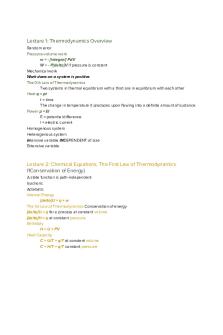
CHEM303 final exam review
- 4 Pages

Psychology Final Exam - Review
- 13 Pages
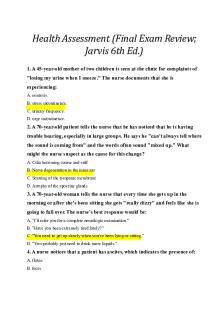
Jarvis Final Exam Review
- 12 Pages
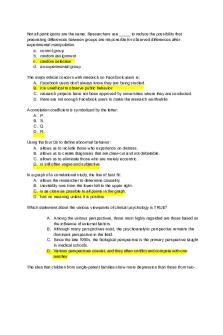
Final exam review
- 96 Pages
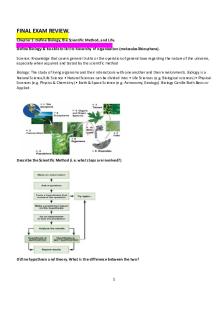
Final Exam Review
- 48 Pages
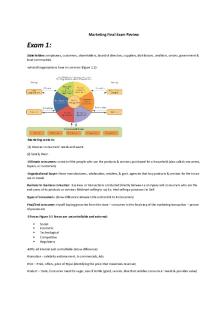
Marketing Final Exam Review
- 15 Pages
Popular Institutions
- Tinajero National High School - Annex
- Politeknik Caltex Riau
- Yokohama City University
- SGT University
- University of Al-Qadisiyah
- Divine Word College of Vigan
- Techniek College Rotterdam
- Universidade de Santiago
- Universiti Teknologi MARA Cawangan Johor Kampus Pasir Gudang
- Poltekkes Kemenkes Yogyakarta
- Baguio City National High School
- Colegio san marcos
- preparatoria uno
- Centro de Bachillerato Tecnológico Industrial y de Servicios No. 107
- Dalian Maritime University
- Quang Trung Secondary School
- Colegio Tecnológico en Informática
- Corporación Regional de Educación Superior
- Grupo CEDVA
- Dar Al Uloom University
- Centro de Estudios Preuniversitarios de la Universidad Nacional de Ingeniería
- 上智大学
- Aakash International School, Nuna Majara
- San Felipe Neri Catholic School
- Kang Chiao International School - New Taipei City
- Misamis Occidental National High School
- Institución Educativa Escuela Normal Juan Ladrilleros
- Kolehiyo ng Pantukan
- Batanes State College
- Instituto Continental
- Sekolah Menengah Kejuruan Kesehatan Kaltara (Tarakan)
- Colegio de La Inmaculada Concepcion - Cebu


